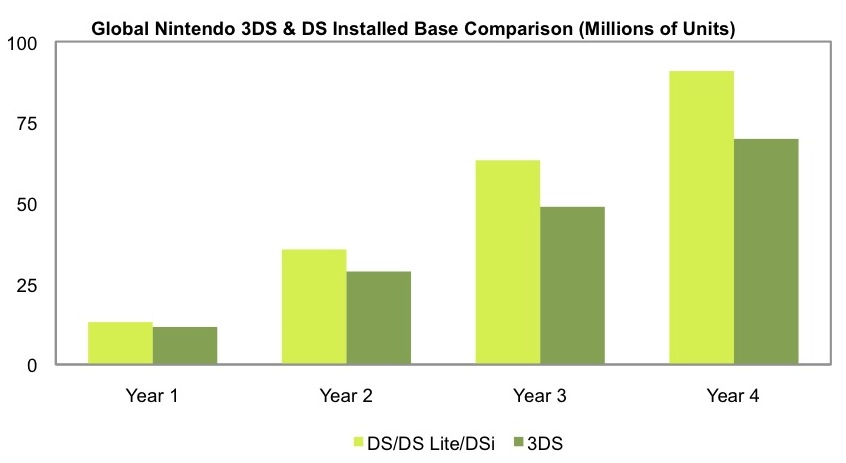 IHS Screen Digest announced that, according to its latest research, growing competition from smartphones and media tablets will prevent sales of Nintendo’s 3DS handheld game system from matching the those of the previous generation DS plaform.
IHS Screen Digest announced that, according to its latest research, growing competition from smartphones and media tablets will prevent sales of Nintendo’s 3DS handheld game system from matching the those of the previous generation DS plaform.
For more information visit: www.screendigest.com
Unedited press release follows:
Nintendo 3DS Sales Expected to be Strong—but Won’t Match Previous-Generation DS
El Segundo, Calif., April 8, 2011—Nintendo Corp.’s strategy of promoting the connectivity and local networking features of its newly released 3DS handheld gaming system in the United States will help drive rapid adoption of the device this year—but won’t allow it to match sales of the previous-generation DS platform, new IHS Screen Digest research reveals.
The 3DS’s 3D graphics and its unique approach to network services has prompted IHS to forecast a global installed base of 11.6 million for the device by the end of 2011. While this represents strong performance, growing competition from the iPod, iPhone and Android smart phone and tablets will prevent the 3DS from matching the sales of the previous-generation Nintendo handheld, the DS.
By 2015, IHS forecasts a global installed base of 70 million 3DS devices. This compares to total sales of DS/DS Lite of 91 million at a comparable point in its sales cycle.
“Nintendo’s accent on network services in the key U.S. market represents an attempt to convince users to carry their 3DS systems with them at all times and to engage with the platform everyday and in every place,” said Piers Harding Rolls, lead games analyst at IHS. “This engagement strategy, alongside 3-D graphics, camera and video, is key to Nintendo competing with upcoming devices from Sony and also from non-specialist smart phones, entertainment devices and tablets, which offer a legitimate alternative to handheld consoles.”
Nintendo previously announced similar services in both Europe and Japan.
3DS offers networking features
Among the connectivity features of the 3DS is StreetPass, a local networking function that allows players to interact with one another through their devices. Players are sent new challenges and content by other users that are passing by. They also can exchange game data such as high scores and game characters. The local network connectivity is meant to encourage users to carry their 3DS with them on their travels and to instill some “magic” around the 3DS community.
Nintendo also is highlighting SpotPass, a 3DS Wi-Fi capability. SpotPass enables the handheld console to connect automatically to wireless local area networks and Wi-Fi hotspots, with content updates pushed to devices even during sleep mode. Furthermore, Nintendo has announced a nationwide deal with AT&T to offer free 3DS user access to more than 10,000 Wi-Fi hotspots, allowing players to obtain free content updates.
Netflix agreement boosts platform’s appeal
Nintendo also has entered into a deal with Netflix to showcase the networked services of the 3DS for U.S. customers.
The agreement will allow movies and 3DS trailers to be streamed to Netflix customers on the 3DS, extending Nintendo’s current arrangement with the bestselling Nintendo Wii TV console. Furthermore, a Nintendo curated short-form-video service offering comedy and music videos also will be made available.
Through these various efforts, Nintendo hopes to leverage what it feels are the unique aspects of the display and connectivity features of the 3DS. The connectivity will be essential for various forms of distribution, while the automatic connection to networks and exchange of content with local users will emphasize the social aspects of the device. In turn, the social functionality will be a core aspect in convincing consumers to use the 3DS on a regular basis and take advantage of the platform’s ability to compete with other similarly connected devices while consumers are on the move.
How 3DS stacks up to against the last generation
The 3DS was released in the United States on March 27 with a price of $249.99. A total of 15 games were set to be available on the same day of the rollout, according to the Nintendo website. 3DS game prices for the U.S. market will average $38.60 this year, reflecting a premium charged for 3-D games, according to IHS Screen Digest estimates.
Nintendo holds a leading position in the specialist handheld games sector, following the very successful DS platform, which at the end of 2010 had sold 136 million units worldwide since appearing in 2004.
Learn more about this topic with IHS Screen Digest Games Intelligence.
About IHS Screen Digest Products & Services
IHS Screen Digest products and services cover global media markets including film, television, broadband media, mobile media, cinema, home entertainment, gaming and advertising. IHS Screen Digest offerings deliver the most complete and insightful analysis of the global technology, media and telecommunications (TMT) markets. More information is available at www.screendigest.com.
About IHS (www.ihs.com)
IHS (NYSE: IHS) is a leading source of information and insight in pivotal areas that shape today’s business landscape: energy, economics, geopolitical risk, sustainability and supply chain management. Businesses and governments around the globe rely on the comprehensive content, expert independent analysis and flexible delivery methods of IHS to make high-impact decisions and develop strategies with speed and confidence. IHS has been in business since 1959 and became a publicly traded company on the New York Stock Exchange in 2005. Headquartered in Englewood, Colorado, USA, IHS employs more than 4,400 people in more than 30 countries around the world.
